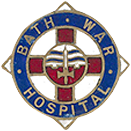Staff
The War Office appointed Dr. G.A. Bannatyne, a doctor at the RUH, Commandant of the War Hospital. He was commissioned as a Lieutenant Colonel in Royal Army Medical Corps, and was awarded the OBE for his service after the war.

Miss Amy B. Hill was appointed Matron, and worked with 13 sisters and 20 staff nurses – (see above image)
There were other full time doctors, and also local GP’s who assisted part-time, but the rest of the staff were largely volunteers, in particular Voluntary Aid Detachments.
Voluntary Aid Detachments
Set up in 1909, the Scheme for the Organisation of Voluntary Aid Detachments in England and Wales set up both male and female Voluntary Aid Detachments to fill certain gaps in the territorial medical services. By early 1914, 1757 female detachments and 519 male detachments had been registered with the War Office. Femal
e detachments varied in size, but in the main consisted of a Commandant, a Medical Officer, a Quartermaster and 22 women, 2 of who were trained nurses.
Most of the auxili ary nurses came from middle or upper class families, and this was their first experience of work outside the home. Initially all VAD’s (as they became collectively known) were unpaid, but later they received £20 a year, out of which they had to provide their own uniforms. Thanks to the letters of Kathleen Ainsworth, who worked at the Bath War Hospital we are able to get an idea of what life was like at the Bath War Hospital. The VAD’s undertook much of the basic work in the hospital – they cleaned, scrubbed and dusted, lit fires, helped the wounded men to dress, undress and wash (which must have been quite a shock for young women who had barely been unchaperoned in male company before!), and changed dressings.
ary nurses came from middle or upper class families, and this was their first experience of work outside the home. Initially all VAD’s (as they became collectively known) were unpaid, but later they received £20 a year, out of which they had to provide their own uniforms. Thanks to the letters of Kathleen Ainsworth, who worked at the Bath War Hospital we are able to get an idea of what life was like at the Bath War Hospital. The VAD’s undertook much of the basic work in the hospital – they cleaned, scrubbed and dusted, lit fires, helped the wounded men to dress, undress and wash (which must have been quite a shock for young women who had barely been unchaperoned in male company before!), and changed dressings.
Kathleen Ainsworth (pictured above) describes the long shifts worked when the hospital trains arrived, and many of the mundane tasks they had to perform, such as washing and ironing bandages.
Male VAD’s also performed an important role, undertaking heavy gardening work and transporting wounded soldiers from the station to the hospital. The Somerset 35, under the command of Cecil Adams, were described by doctors travelling on the hospital trains as providing one of the best services in the country. Cecil Adams also created a cycle wheeled transporter to move stretcher case soldiers from the trains to the ambulances.

